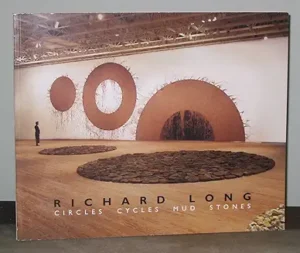Richard Long: Circles Cycles Mud Stones ed. by Marti Mayo 1996
Long is another British artist, born after WWII who after attending the same art school with Hamish Fulton, abandoned the brush and the chisel, and adopted the approach of using the natural environment as his canvas. Like Fulton whose work was recently on display at a gallery in Boston and whose prints hang on my wall in Cambridge, two of Long’s stone shapes on the ground are on exhibit at the nearby Hall Art Foundation in Vermont, and one of his works on paper hangs on a wall in Cambridge.
Unlike Fulton, however, whose approach is to ‘leave no trace’, Long makes semi-permanent marks on the environment. From paths trodden in the grass to stones arranged in circles or along a road to mark miles, Long utilizes the environment to make his art, choosing space and the nearly two-dimensional aspect of the ground to express his art.
This book is the catalogue from a one man show of Long’s work exhibited at the Contemporary Arts Museum in Houston in 1996. Two essays accompany fine reproductions of Long’s circles made from Texas sandstone, flint, driftwood, and other materials on the floor as well as his monumental mud circles on the walls. The first essay focuses on the works in the exhibit while the second places Long in the tradition of English art, and more specifically, sculpture. Looking back all the way to Stonehenge’s circle, Long’s circles, both in nature and indoors, are in the tradition described in a 1937 book entitled ‘Circle’ which featured essays by Barbara Hepworth, Anthony Caro, Henry Moore, and others. Moore wrote the following which is a fitting description of Long’s work: “I dislike the idea that contemporary art is an escape from life. Because a work does not aim at reproducing the natural appearance it is not therefore an escape from life—it may be penetrating into reality; not a sedative or a drug, not just the exercise of good taste, the provision of pleasant shapes and colors in a pleasing combination, not a decoration to life—but an expression of the significance of life, stimulation to a greater effort in living.”
Long’s work, like that of Fulton, brings together my favorite elements—nature and art and their interaction. Whether on my walls or in a museum or an outdoor sculpture gallery, Long’s work is beautiful and moving.



